
Cosmic rays or astroparticles are high-energy particles or clusters of particles that move through space at nearly the speed of light. They originate from the Sun, from outside of the Solar System in our own galaxy, and from distant galaxies. Upon impact with Earth's atmosphere, cosmic rays produce showers of secondary particles, some of which reach the surface, although the bulk are deflected off into space by the magnetosphere or the heliosphere.

A scintillation counter is an instrument for detecting and measuring ionizing radiation by using the excitation effect of incident radiation on a scintillating material, and detecting the resultant light pulses.

A scintillator is a material that exhibits scintillation, the property of luminescence, when excited by ionizing radiation. Luminescent materials, when struck by an incoming particle, absorb its energy and scintillate. Sometimes, the excited state is metastable, so the relaxation back down from the excited state to lower states is delayed. The process then corresponds to one of two phenomena: delayed fluorescence or phosphorescence. The correspondence depends on the type of transition and hence the wavelength of the emitted optical photon.
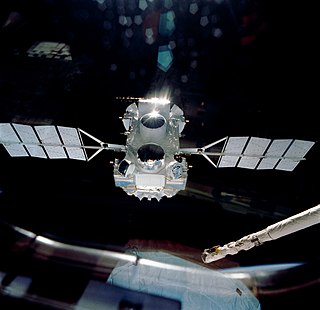
The Compton Gamma Ray Observatory (CGRO) was a space observatory detecting photons with energies from 20 keV to 30 GeV, in Earth orbit from 1991 to 2000. The observatory featured four main telescopes in one spacecraft, covering X-rays and gamma rays, including various specialized sub-instruments and detectors. Following 14 years of effort, the observatory was launched from Space Shuttle Atlantis during STS-37 on April 5, 1991, and operated until its deorbit on June 4, 2000. It was deployed in low Earth orbit at 450 km (280 mi) to avoid the Van Allen radiation belt. It was the heaviest astrophysical payload ever flown at that time at 16,300 kilograms (35,900 lb).

Neutrino astronomy is the branch of astronomy that gathers information about astronomical objects by observing and studying neutrinos emitted by them with the help of neutrino detectors in special Earth observatories. It is an emerging field in astroparticle physics providing insights into the high-energy and non-thermal processes in the universe.
A semiconductor detector in ionizing radiation detection physics is a device that uses a semiconductor to measure the effect of incident charged particles or photons.

A gamma-ray spectrometer (GRS) is an instrument for measuring the distribution of the intensity of gamma radiation versus the energy of each photon. The study and analysis of gamma-ray spectra for scientific and technical use is called gamma spectroscopy, and gamma-ray spectrometers are the instruments which observe and collect such data. Because the energy of each photon of EM radiation is proportional to its frequency, gamma rays have sufficient energy that they are typically observed by counting individual photons.
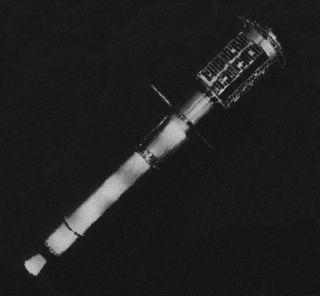
Explorer 11 was a NASA satellite that carried the first space-borne gamma-ray telescope. This marked the beginning of space gamma-ray astronomy. Launched on 27 April 1961 by a Juno II, the satellite returned data until 17 November 1961, when power supply problems ended the science mission. During the spacecraft's seven-month lifespan it detected twenty-two events from gamma-rays and approximately 22,000 events from cosmic radiation.

HEGRA, which stands for High-Energy-Gamma-Ray Astronomy, was an atmospheric Cherenkov telescope for Gamma-ray astronomy. With its various types of detectors, HEGRA took data between 1987 and 2002, at which point it was dismantled in order to build its successor, MAGIC, at the same site.

HEAO-1 was an X-ray telescope launched in 1977. HEAO-1 surveyed the sky in the X-ray portion of the electromagnetic spectrum, providing nearly constant monitoring of X-ray sources near the ecliptic poles and more detailed studies of a number of objects by observations lasting 3–6 hours. It was the first of NASA's three High Energy Astronomy Observatories, HEAO 1, launched August 12, 1977 aboard an Atlas rocket with a Centaur upper stage, operated until 9 January 1979. During that time, it scanned the X-ray sky almost three times
The Chicago Air Shower Array (CASA) was a significant ultra high high-energy astrophysics experiment operating in the 1990s. It consisted of a very large array of scintillation detectors located at Dugway Proving Grounds in Utah, USA, approximately 80 kilometers southwest of Salt Lake City. The full CASA detector, consisting of 1089 detectors began operating in 1992 in conjunction with a second instrument, the Michigan Muon Array (MIA), under the name CASA-MIA. MIA was made of 2500 square meters of buried muon detectors. At the time of its operation, CASA-MIA was the most sensitive experiment built to date in the study of gamma ray and cosmic ray interactions at energies above 100 TeV (1014 electronvolts). Research topics on data from this experiment covered a wide variety of physics issues, including the search for gamma rays from Galactic sources (especially the Crab Nebula and the X-ray binaries Cygnus X-3 and Hercules X-1) and extragalactic sources (active Galactic nuclei and gamma-ray bursts), the study of diffuse gamma-ray emission (an isotropic component or from the Galactic plane), and measurements of the cosmic ray composition in the region from 100 to 100,000 TeV. For the topic of composition, CASA-MIA worked in conjunction with several other experiments at the same site: the Broad Laterial Non-imaging Cherenkov Array (BLANCA), the Dual Imaging Cherenkov Experiment (DICE) and the Fly's Eye HiRes prototype experiment. CASA-MIA operated continuously between 1992 and 1999. In summer 1999, it was decommissioned.
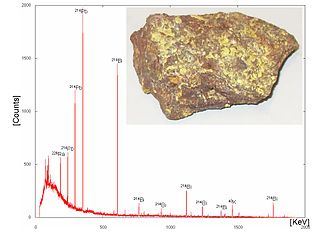
Gamma-ray spectroscopy is the qualitative study of the energy spectra of gamma-ray sources, such as in the nuclear industry, geochemical investigation, and astrophysics. Gamma-ray spectrometry, on the other hand, is the method used to acquire a quantitative spectrum measurement.

Neutron detection is the effective detection of neutrons entering a well-positioned detector. There are two key aspects to effective neutron detection: hardware and software. Detection hardware refers to the kind of neutron detector used and to the electronics used in the detection setup. Further, the hardware setup also defines key experimental parameters, such as source-detector distance, solid angle and detector shielding. Detection software consists of analysis tools that perform tasks such as graphical analysis to measure the number and energies of neutrons striking the detector.

A neutrino detector is a physics apparatus which is designed to study neutrinos. Because neutrinos only weakly interact with other particles of matter, neutrino detectors must be very large to detect a significant number of neutrinos. Neutrino detectors are often built underground, to isolate the detector from cosmic rays and other background radiation. The field of neutrino astronomy is still very much in its infancy – the only confirmed extraterrestrial sources as of 2018 are the Sun and the supernova 1987A in the nearby Large Magellanic Cloud. Another likely source is the blazar TXS 0506+056 about 3.7 billion light years away. Neutrino observatories will "give astronomers fresh eyes with which to study the universe".

The last of NASA's three High Energy Astronomy Observatories, HEAO 3 was launched 20 September 1979 on an Atlas-Centaur launch vehicle, into a nearly circular, 43.6 degree inclination low Earth orbit with an initial perigeum of 486.4 km. The normal operating mode was a continuous celestial scan, spinning approximately once every 20 min about the spacecraft z-axis, which was nominally pointed at the Sun. Total mass of the observatory at launch was 2,660.0 kilograms (5,864.3 lb).
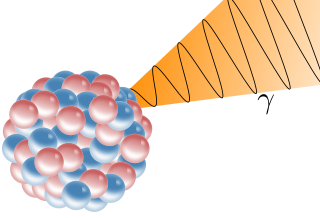
A gamma ray, also known as gamma radiation (symbol
γ
), is a penetrating form of electromagnetic radiation arising from the radioactive decay of atomic nuclei. It consists of the shortest wavelength electromagnetic waves, typically shorter than those of X-rays. With frequencies above 30 exahertz (3×1019 Hz) and wavelengths less than 10 picometers (1×10−11 m), gamma ray photons have the highest photon energy of any form of electromagnetic radiation. Paul Villard, a French chemist and physicist, discovered gamma radiation in 1900 while studying radiation emitted by radium. In 1903, Ernest Rutherford named this radiation gamma rays based on their relatively strong penetration of matter; in 1900, he had already named two less penetrating types of decay radiation (discovered by Henri Becquerel) alpha rays and beta rays in ascending order of penetrating power.
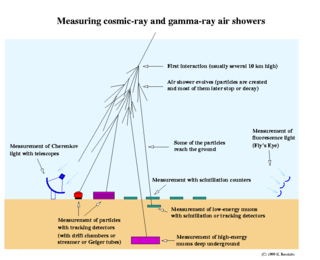
A cosmic-ray observatory is a scientific installation built to detect high-energy-particles coming from space called cosmic rays. This typically includes photons, electrons, protons, and some heavier nuclei, as well as antimatter particles. About 90% of cosmic rays are protons, 9% are alpha particles, and the remaining ~1% are other particles.
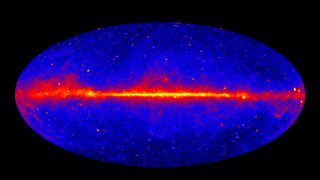
Gamma-ray astronomy is a subfield of astronomy where scientists observe and study celestial objects and phenomena in outer space which emit cosmic electromagnetic radiation in the form of gamma rays, i.e. photons with the highest energies at the very shortest wavelengths. Radiation below 100 keV is classified as X-rays and is the subject of X-ray astronomy.

Kenneth John Frost was a pioneer in the early space program, designing and flying instruments to detect and measure X-rays and gamma-rays in space, primarily from the Sun. He was the first to suggest the use of an active scintillation shield operated in electronic anticoincidence with the primary detector to reduce the background from cosmic ray interactions, an innovation that made sensitive hard X-ray and gamma-ray astronomy possible. He was an American astrophysicist at Goddard Space Flight Center working as a civil servant for the National Aeronautics and Space Administration. During his career, he was the project scientist of the Solar Maximum Mission, principal investigator of six science instruments, the head of the Solar Physics Branch, and the associate director of Space Sciences.
In particle physics, the coincidence method is an experimental design through which particle detectors register two or more simultaneous measurements of a particular event through different interaction channels. Detection can be made by sensing the primary particle and/or through the detection of secondary reaction products. Such a method is used to increase the sensitivity of an experiment to a specific particle interaction, reducing conflation with background interactions by creating more degrees of freedom by which the particle in question may interact. The first notable use of the coincidence method was conducted in 1924 by the Bothe–Geiger coincidence experiment.

















